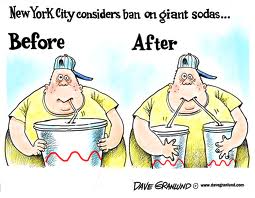In a previous blog post, I discussed a study that addressed one of New Yorkers’ biggest concerns about Mayor Michael Bloomberg’s proposed ban on soda and sugary beverages larger than 16 ounces: how lower income citizens may be disproportionately affected by the ban compared to others who can afford to just buy multiple sodas. Aside from the negative societal affect many feel the mayor’s plan will have, another big problem that opponents of the ban have is that the portion cap won’t even work in the first place, in terms of curbing the rising rates of obesity in New York City. Many a study has been done to test whether or not that is true but through my searches, it seems to me that a good portion of the success of the soda ban is dependent on plain human behavior.
Dr. Brian Elbel, assistant professor at the NYU Langone School of Medicine conducted a study over the years 2008 through 2010 in order to get some information about how the proposed portion cap can affect the average consumer’s caloric intake. Along with fellow NYU researchers, he collected and analyzed 1,624 fast food restaurant receipts from diners in the NYC, Newark, N.J., Philadelphia and Baltimore areas. He found that 62% of non-dairy beverages purchased were over 16 ounces and would thus have been subject to the ban had it been passed. By the end of his study, Elbel found that if all fast food buyers stuck with 16-ounce beverages, the average customer could benefit from 63 less calories per fast food meal. He also found that, “…if 100 percent of sugary drink purchasers alone switched to the smaller soda, the reduction may be as high as 74 calories per fast food trip.” Seventy-four fewer calories for 100% of sugary drink purchasers who opt for smaller sodas is a pretty good result in my opinion. It can go to show that Mayor Bloomberg’s idea of urging New Yorkers to cut down on their soda intake by means of the ban is a reasonable plan.
Simple enough, right? Not exactly. Opponents of the ban feel that instead of people magically not drinking more than 16 ounces of sugar laden drinks at a time because of the ban, they would be driven, to buy multiple 16 ounce beverages in order to be able to still drink as much as they used to! So, what does happen if people buy two 16- ounce sodas instead of one? Elbel found that if the ban doesn’t work and 80% of people decide to buy two sodas, caloric intake from sugary drinks would actually increase.
In this branch of the soda ban war, it appears that it comes down to what people decide to do if the ban does get passed. What factors would lead people to buy two 16 ounce sodas? Do we really crave that much soda? Or will most people just find it inconvenient to have to, in most cases (like at sporting arenas, movie theatres and delis), carry around two cups of soda? I know I wouldn’t but I don’t know what the rest of society would tend to do. It’s not always easy to predict human behavior…